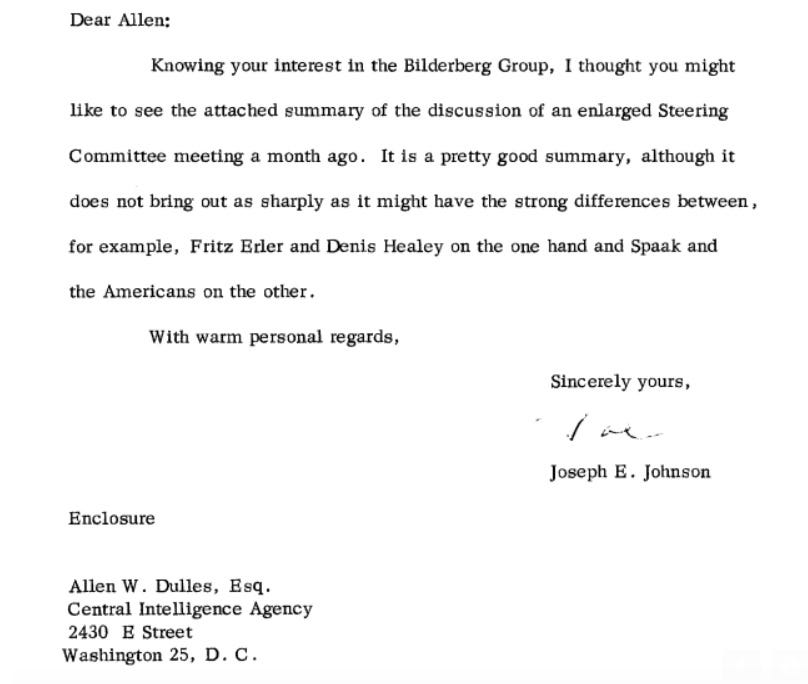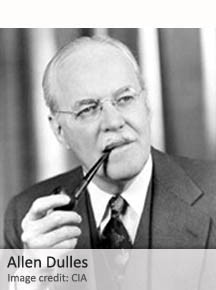Secret History: From the Fringes to the Mainstream. Part I: Bilderbergers Come to Vermont and the CFR’s School for Statesmen
 –>
–>
Exclusive groups with hidden agendas aren’t paranoid fantasies, or just popular plot points for movies. There have been, and continue to be, actual covert schemes and conspiracies, both above and under ground, and secretive elites with hidden, manipulative or sometimes dangerous game plans. Not all of them are bent on destruction; some just want to disrupt the status quo, others may even have altruistic goals. And fortunately, no one of them yet has put all of humanity completely under their thumbs. On the other hand, they are not to be underestimated or ignored.
In the late 1970s, the Trilateral Commission took the lead through President Jimmy Carter, looking toward a global power-sharing arrangement between the US, Europe (led by Germany), and Japan. That plan didn’t get too far. During the Reagan years, trilateralism gave way to the Heritage Foundation, which developed a more nativist blueprint, a bit like Trump’s Project 2025. Heritage didn’t just promote a militant response to foreign threats. It took direct aim at “the un-American nature of so much so-called dissidence.” Reagan gave the implementation job largely to his chief lawyer, Edwin Meese, who had attended Heritage meetings and reportedly “relied heavily” on its advice as attorney general.
Before either Heritage or the Trilateralists, there was the Bilderberg group, whose mere existence was once hard to swallow. Maybe it was that unlikely name. If you added that it met annually — with no press coverage, and yet made major international policy decisions, the usual reaction was an arched eyebrow. Today, however, with the idea of a “deep state” and “great replacement” conspiracy widely accepted on the right, plus historical revisions being pushed into textbooks and schools, it doesn’t sound as far-fetched.
Image: Prince Bernhard of Lippe-Biesterfeld (Licensed under CC BY-SA 3.0 nl)

The name came from the hotel in Oosterbeek, Holland used for the first session in 1954. After that, meetings were held around the world, including a 1971 gathering in Woodstock, Vermont.
“The purpose of the conference,” said Prince Bernhard, the Dutch aristocrat who promoted the group and chaired meetings for more than 30 years, “is that eminent persons in every field get the opportunity to speak freely without being hindered by the knowledge that their words and ideas will be analyzed, commented upon and eventually criticized in the press.”
At the time, Bernhard, who married Holland’s Princess Juliana, was a spokesman for NATO as well as Dutch interests in South America.
Nevertheless, US Senator James Buckley wrote in 1974 that,
“I don’t subscribe to the theory that there exists an organization of international bankers called the Bilderbergers.”
A strange reaction since his brother, William F. Buckley, was on the guest list that year.
Or consider this evasion. In response to an inquiry in 1975 a US Justice Department official said the White House knew nothing about the Bilderbergers. Yet President Ford attended meetings of the group throughout the 1960s, and Donald Rumsfeld, both Chief of Staff and Secretary of Defense under Ford, knew the group as “an open forum for the exchange of ideas.”
The Bilderberg Group rarely appeared in CIA files. In 1975, however, declassified staff notes mentioned the conference in one paragraph. They revealed that the event would be held in Turkey that April. Inflation was to be discussed and UK Prime Minister Thatcher had been invited.
After the 1971 Vermont session, a hotel employee put it succinctly:
“They get together once a year to talk about what is going to happen in the world.”
.

.
In May 1958, Joseph Johnson, a member of the Bilderberg Steering Committee, responded to an inquiry from the CIA’s Allen Dulles about the group’s recent activities.
Officially, the Bilderberg meeting in Woodstock, convening April 23, 1971, was billed as “an international peace conference.” US State Department officials had conferred with Vermont State Police about the security arrangements. The state supplied 30 men in plain clothes to support a private, armed security force, the FBI and Secret Service, even though several Vermont officials claimed they knew nothing about the event.
150 guards and officers blanketed what was then a small town of 1,600, sealing off Laurence Rockefeller’s hotel and estate. Everything was set for the arrival of 85 leaders from around the world. Limousines brought them from Lebanon, New Hampshire, where an air shuttle from Boston had been arranged.
Although Bernhard issued a terse press statement when his plane touched ground at Boston’s Logan Airport, one participant, Francois Duchene of the London Institute of Strategic Studies, who attended with then British Defense Minister Denis Healey, later explained that,
“America must face a Western Europe and Japan that are more independent.”
That fit, since one scheduled topic was, “A change in the US role in the world.”
To Major Glenn Davis of the Vermont State Police it was “a hairy scene. No one seemed to know just who was in charge of what.” But in the conference room, once all employees had been cleared from the building, order reigned. Seating was arranged alphabetically with Bernhard at the head of the table. Remarks were normally limited to five minutes, with two “working papers” as discussion foci.
Henry Kissinger, then Nixon’s National Security Advisor, missed the first session, but became the main event when he delivered a briefing on US plans. Months later, he was charged by conservatives with leaking news about an upcoming China trip by President Nixon and a devaluation of the dollar. After the 1971 conference banks and major corporations shifted capital out of the US, mainly to West Germany. Nixon’s China initiative eventually became public information. In December, the dollar was devalued, resulting in gains for people who had already converted to European currency. A “change in the US role” was under way, Bilderbergers may have helped make it happen, and clearly knew in advance.
When I wrote about it later, Marcellus Parsons, news director at WCAX, Burlington’s leading TV station, complained to my editor about the story. The event wasn’t so secret, he claimed, comparing my coverage to a story in the conservative Manchester Union Leader, which headlined it as “Secret Meeting in Secluded Resort.” Journalists just couldn’t get in to cover it, he argued. “These meetings are not as secret in Europe as they are here,” Parsons added, but mainly because the US press “really didn’t give a damn.” And what was so wrong, he concluded, with economic and political leaders “who just want to sit down for a giant off the record bull session.”
The truth is that private groups like the Bilderbergers, which helped to build a post-war system of de facto global management, didn’t often actually discuss peace. Rather, their main concern was managing the world economy. Originally, Bilderberg meetings were meant to strengthen the Atlantic alliance, and gradually became an open conspiracy to develop consensus among political and business leaders beyond the power of nation states. In the 1950s, Prince Bernhard brought the idea to the CIA, and with its assistance won support from the Ford and Rockefeller foundations. The money flowed through the Carnegie Endowment for International Peace, whose director, Joseph Johnson, coordinated US Bilderberg activities.
Over the years the group became a model for transnational diplomacy, lending support to European integration and oil company policies. Its steering committee was a who’s who of international finance; David Rockefeller, Gabriel Hauge (Manufacturer’s Hanover Trust), Emilio Collado (Standard Oil, later Exxon), and international lawyers such as Arthur Dean and George Ball. All US steering committee members were also members of the Council on Foreign Relations (CFR), which had dominated US foreign policy planning since World War II.
One key member was George Ball, a long-time CFR member, director of the Trilateral Commission, Undersecretary of State, and lawyer with Lehman Brothers. Another was Arthur Dean, CFR member, and partner in the Sullivan and Cromwell law firm, whose other partners included John Foster and Allen Dulles. Before World War II Sullivan and Cromwell had worked with German chemical and steel monopolies. By the time the Bilderbergers began to meet, attorney Allen Dulles had become CIA director.
The Council on Foreign Relations had ties to the financial empires of Rockefeller, Rothschild and Morgan. Although its philosophical roots can be traced back to Fabian Socialism, it was later instrumental in creating the World Bank and the International Monetary Fund. For decades, its resident members and “international citizens” formed an aristocracy of financiers, academics, lawyers, journalists and public officials who profoundly influenced US foreign policy from the 1940s to the rise of Trump. It still publishes a monthly journal, Foreign Affairs.
Columnist Joseph Kraft, a CFR member, once called this semi-secret elite a “school for statesmen.” For more than half a century, its main objective was to create a “new international order.” To many leftists that read as US imperialism; to right-wingers it translated roughly as world government.
The CFR was born at the Majestic Hotel in Paris, May 19, 1919, just as the World War I peace talks were winding down. The meeting to create an international planning group was called by “Colonel” Edward Mandell House, Texas oil man, power broker and presidential advisor, whom Wilson called his “alter ego.” The Colonel’s Paris conference was geared to generate support from finance czars (the gold and dollars alliance of Rothschild and Rockefeller) and liberal internationalists.

By 1950 CFR members and influencers filled many American cabinet posts. Its members were a new nobility: Nelson Rockefeller, Averill Harriman, Dean Rusk, Walter Lippman, and Allen Dulles, to name but a few.
When Dulles died in 1969, President Nixon said,
“In the nature of his task, his achievements were known to only a few.”
Dulles’ main tasks from the 1940s on were intelligence gathering, spreading disinformation and staging covert operations. He viewed this as a craft, and managed to elevate espionage to professional status. As much the architect as the prosecutor of the Cold War, he handled many of the CFR’s and CIA’s “dirty tricks.”
Back in 1919 Dulles had attended the Paris talks with “Colonel” House, then joined the US State Department. By the late 1920s he had become a partner in the Wall Street law firm of Sullivan and Cromwell, which worked with Adolph Hitler’s financial agent to acquire the largest German monopolies, steel and chemicals, as clients. Dulles joined the board of the Henry Schroeder Trust banking group in the 1930s, while Schroeder helped to bankroll the Nazis.
But allegiances changed when the war began. Dulles left the firm and began spying at a high level in the Office of Strategic Services (OSS), a new US intelligence and subversion network that evolved into the CIA. In 1944 the spymaster worked on two key covert missions: liquidating the Fuhrer and working out peace terms with other Nazis without letting Russia find out.
*
Click the share button below to email/forward this article. Follow us on Instagram and X and subscribe to our Telegram Channel. Feel free to repost Global Research articles with proper attribution.
Greg Guma is a Vermont writer, former editor, and author of 15 books, including Managing Chaos: Adventures in Alternative Media. Visit the author’s blog. He is a regular contributor to Global Research.
Featured image: Hotel de Bilderberg in Oosterbeek, Holland, site of the Bilderbergers’ first meeting
Global Research is a reader-funded media. We do not accept any funding from corporations or governments. Help us stay afloat. Click the image below to make a one-time or recurring donation.



